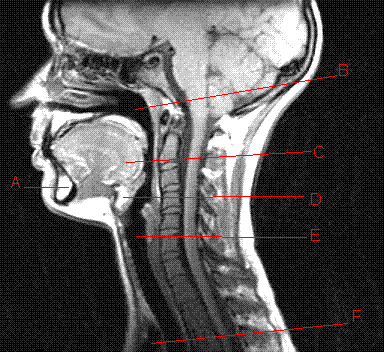 Brain Teaser #20
Brain Teaser #20
A) Question:
In relationship to the trachea, where does the esophagus lie anatomically?
A) Answer:
The esophagus lies posterior to the trachea.
B) Question:
What is the most common lymphatic spread of laryngeal cancer?
B) Answer:
The most common spread is to the subdigastric nodes.
C) Question:
When treating early stage layrngeal cancer (T1 to T2), what kind of beam arrangement is typically used?
C) Answer:
The beam arrangement typically used is opposed laterals.
D) Question:
When treating early stage layrngeal cancer (T1 to T2), what kind of energy is typically used?
D) Answer:
The energy typically used is photons and lower energy photons (such as 6 MV).
E) Question:
What are some typical field sizes for an early stage larynx cancer (T1 to T2)?
E) Answer:
Typical field sizes range from 4 x 4 to 6 x 6.
Follow Up:
This can vary slightly depending on how much involvement a patient has.
F) Question:
When treating early stage layrnx cancer (T1 to T2), do you have to come off cord at specific dose?
F) Answer:
No, typically you don't have to come off cord.
Follow Up:
Even with the larynx going to high doses (in most cases well above 6,000 cGy), the posterior border does not go though the cord for most early stage layrnx treatments. Thus, there is no reason to “come off cord”.
G) Question:
When treating early stage layrnx cancer (T1 to T2), do you expect flash to be present?
G) Answer:
Yes, you expect flash to be present. There should be flash present in the anterior direction.
H) Question:
Where is the larynx located on this diagram (which letter)?

H) Answer:
Letter E represents the layrnx

I) Question:
A patient is being treated with rapid arc. The total rotation of the arc is 240 degrees. The total monitor units for this arc are 360 MU. The total dose is 180 cGy. What are the monitor units that will be given per degree?
I) Answer:
1.5 MU/degree will be given.
Follow Up:
Simply dived monitor unit by degree to get MU/Degree.
So, 360 MU/240 degrees = 1.5 monitor units/degree
J) Question:
The patient is being treated with rapid arc. The total rotation of the arc is 240 degrees. The total monitor units for this arc are 360 MU. The total dose is 180 cGy. As the arc is being delivered, there is a power failure with the arc only going 187 degree. What dose has been delivered to the patient [assume equal dose per degree]?
J) Answer:
140.25 cGy was delivered
Follow Up:
Take 180 cGy divided by 240 degrees to get the amount of dose per degree. This equals .75 cGy/degree. Next take the degree delivered and multiply by the dose per degree.
So, (.75 cGy)(187 degrees) = 140.25 cGy.
K) Question:
The patient is being treated with rapid arc. The total rotation of the arc is 240 degrees. The total monitor units for this arc are 360 MU. The total dose is 180 cGy. As the arc is being delivered, there is a power failure with the arc only going 187 degrees. How much dose WAS NOT delivered [Again, assume equal dose per degree]?
K) Answer:
39.75 cGy was not delivered.
Follow Up:
Simply take you total dose, in this case 180 cGy and subtract it from the dose delivered.
So, 180 cGy – 140.25 cGy = 39.75 cGy
L) Question:
The patient is being treated with rapid arc. The total rotation of the arc is 240 degrees. The total monitor units for this arc are 360 MU. The total dose is 180 cGy. As the arc is being delivered, there is a power failure with the arc only going 187 degrees. What percentage of dose was delivered to the patient that day [Again, assume equal dose per degree]?
L) Answer:
77.9% of the dose was delivered.
Follow Up:
Simply set up a proportion using total dose delivered from the previous question.
So, 180/100 = 140.25/x.
Solve for x and x is 77.9%.
THE END
Author: Jason Sheehan
Editors: Adam Buell and Joan O'Brien
Date Created: March 2010


